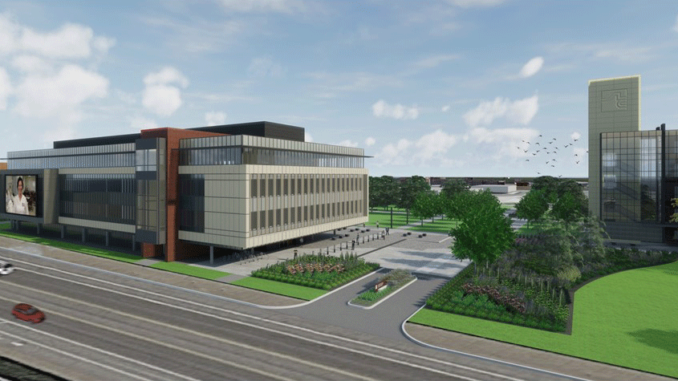A midcentury landmark will fall to the wrecking ball to make room for new green space along the south side of Forest Park according to plans by St. Louis Community College. North of that site, KAI Design & Build is designing a new $39 million Center for Nursing and Health Sciences.
As reported in The Scene, the print and online newspaper of St. Louis Community College Forest Park, the historic A and B towers will be demolished for green space. (link: http://thescenefp.com/2017/10/06/college-break-ground-health-center/) A site plan by KAI shows a grassy rectangular lot where Kiley’s towers now stand. The Scene quotes Forest Park Provost Larry Johnson as saying, “The footprint of the A and B towers will become green space.” The plan preserves all of the school’s extensive asphalt surface parking lots.
The new building will be a four-story 96,000 square foot facility. Provost Johnson explains, “The new facility will be state-of-the art with resources that will give our students an edge in the job market.” Construction will begin in March 2018. The school will demolish Wesse’s towers in 2019.
While the new facility will front Oakland Avenue, its design makes no visible reference Weese and Kiley’s design. It remains unclear why the A and B towers will be demolished, and why surface parking could not be sacrificed instead of a collaborative work by three great midcentury architects.
Noted Modernist Harry Weese designed the Forest Park campus between 1964 and 1967 with his brother Ben Weese (later one of the Chicago Seven) and Dan Kiley, the Father of Modern Landscape Architecture. (link: https://nextstl.com/2017/04/weese-kileys-mid-century-forest-park-campus-threatened/) Kiley is known locally for his design of the Gateway Arch grounds. Weese and Kiley’s design for Forest Park Community College won the first ever 25-Year Award bestowed by the American Institute of Architects, St. Louis Chapter in 1994 for buildings that have “withstood the test of time.”





